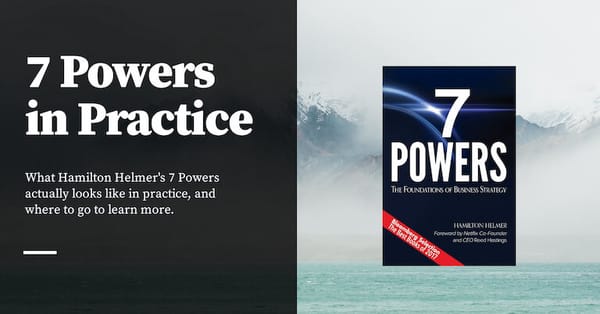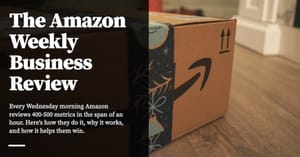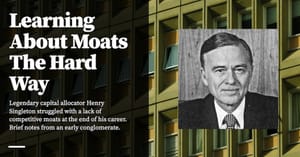In last week’s summary of Hamilton Helmer’s 7 Powers, I presented Helmer’s argument that the goal of business strategy is to find some … thing to defend against competitive arbitrage. Helmer called these things ‘Powers’, which are essentially the same thing as Warren Buffett’s ‘moats’; he argued that there are really only seven of them.
One way of reading 7 Powers is that it is an analytical lens for evaluating companies. This is indeed a valid take: near the end of the book Helmer says that he used the Powers to gain an analytical edge at his hedge fund; he reports that he generated an average annual alpha of 24.3% (risk adjusted) over the course of 17 years.
But this blog is concerned with business from the perspective of an operator, not necessarily from the perspective of an investor. How do you use the 7 Powers framework if you are running a business? I wrote, at the end of my summary:
The irony is that while the end goal of every business is Power — that is, sustainable competitive advantage; the path itself consists of short-term tactical advantages. In other words, the way to achieve long-term differential margins are through a million small operational tweaks; the road to sustainable advantage is with unsustainable advantage — or at least, unsustainable advantage and invention. At least with 7 Powers you know that there are only seven forms that advantage can take, and each of them emerge at a particular point in the business's life. As Helmer puts it: it's not everything, certainly, but it's a lot.
The basic argument that 7 Powers makes is that — if you are a businessperson — you should keep the Powers at the back of your mind as you pursue operational excellence. You’d be correct to think ‘ah, this is straightforward, I shall just keep an eye out for a route to possible Power’ — even as you accept that the route might not be clear to you when you first start out on your journey.
But it’s very likely that you would be taken by surprise if you don’t shore up this theoretical foundation with examples from history. The truth is that business execution in pursuit of Power is a lot … weirder than you might think. Here are a handful of stories to illustrate what I mean.
Sometimes Competitive Arbitrage Shows Up Late
Helmer’s whole argument in 7 Powers is that margin compression happens because of competitive arbitrage — basically, you do something hugely profitable, word gets out, and then those profits attracts competitors who enter the market, copy you, and drive your margins down.
This is broadly true: over the long term, word always gets out, and competitors will show up to give you a hard time. But sometimes it takes years before this happens — meaning that it is totally possible for you to grow your business, rake in profits, and build Power in an oddly empty environment long before others swoop in.
Take Shopify’s rise, for instance. On the Acquired podcast hosts Ben Gilbert and David Rosenthal observe that the e-commerce provider market was bizarrely empty when Shopify was on the rise:
For some strange reason, Shopify managed to grow without serious competition for much of its early life. You can hear the @AcquiredFM guys ponder this (they riff on Magento at the beginning, another non-serious competitor): pic.twitter.com/RlRwuReFGP
— Cedric Chin (@ejames_c) June 13, 2021
Ben: It was a strangely empty space — I mean, Tobi talks about one of the hard things was that they didn’t have a big competitor; their competitors were these incumbents and really crappy experiences — so, Yahoo Stores, and everyone else that he’s ripped to pieces, and he kinda says that ‘we’ve had to have a higher bar because we didn’t have real competition’ — and so it is interesting where there’s this strange lull in the market. Viaweb was started and it was sold to Yahoo, Magento was around … but there wasn’t another low-end disruption e-commerce provider for the better part of a decade, and now you have people trying to compete with Shopify, because it looks like a very real market, but yeah — there wasn’t really anyone who would’ve come in and done exactly what they did when they did it otherwise.
This was also the case for Amazon Web Services. As many tech observers have pointed out — it took a decade before people understood just how profitable cloud services really were, and therefore a decade before heated competition kicked in. In Amazon Unbound, writer Brad Stone documents this lag:
Over its first decade, AWS’s revenues and profits were a closely guarded secret. The division generated $4.6 billion in sales in 2014 and was growing at a 50 percent annual clip. But Amazon disguised those numbers, along with nascent advertising revenues, in a sundry “other” category on its income statement, so that potential competitors like Microsoft and Google would not recognize how attractive a business cloud computing actually was. Observers and analysts could only guess at the financial dimensions of a unique enterprise computing business, anomalously tucked inside an online retailer.
This secret was very much a deliberate thing:
(…) both (Bezos) and Jassy lobbied to conceal the division’s financial details from public view, even amid the widespread skepticism that throttled the company and its stock price in 2014. But in 2015, Amazon’s finance department argued that the division’s revenue was approaching 10 percent of Amazon’s overall sales and would eventually trigger reporting requirements under federal law. “I was not excited about breaking our financials out because they contained useful competitive information,” Jassy admitted.
Nevertheless, that January, Amazon signaled that it would report AWS’s financial results in its quarterly report for the first time, and investors girded in anticipation. Many analysts predicted that AWS would be revealed as just another Amazon “science project”—a lousy, low-margin business that was sapping energy from the company’s more advanced efforts in retail.
In reality, the opposite was true. That year, AWS had a 70 percent growth rate and 19.2 percent operating margin, compared to the North American retail group’s 25 percent growth rate and 2.2 percent operating margin. AWS was gushing cash, even as it rapidly consumed most of it to build even more computing capacity and keep up with the fast-growing internet companies like Snapchat that were piling onto its servers.
This reporting was a huge surprise for the analysts and investors who monitored and scrutinized Amazon, and likely even a bigger one for Microsoft, Google, and the rest of the enterprise computing world. Analyst Ben Thompson facetiously called that April 2015 earnings report “one of the technology industry’s biggest and most important IPOs.” After the reveal, Amazon’s valuation jumped almost 15 percent in a day, crossing the $200 billion mark for the first time and laying to rest the myth of Amazon as a perpetually money-losing machine.
Today, cloud computing is a knife fight — Amazon’s 2015 disclosure meant that the market could never be the same again. Still, you would have thought that knowledge of cloud computing’s profitability would’ve slipped out earlier than a decade into the business. The 10 year lag that AWS enjoyed meant that it had 10 years to build a lead, and 10 years before it needed to worry about full-blown competitive arbitrage.
How do you predict when competitive arb would kick in? I have no idea. Some markets simply become knife fights within five years; others become knife fights after 10. Sometimes you’re lucky, and sometimes you’re not.
Uncertainty is the First Moat
Shopify’s and AWS’s stories lend colour to the application of Helmer’s theory. You might say that competitive arbitrage lagged discovery because knowledge of lucrative profits was unevenly distributed throughout the tech industry — and you would be right! But there is another way to look at this. When you lack information about the profitability of a business, a cloak of uncertainty protects the challenger.
Venture capitalist Jerry Neumann points out that uncertainty is always your first moat when you’re building a high-growth-potential startup. He opens his piece by asking: if Apple was at the cusp of growing into the soon-to-be explosive personal computer market, why didn’t the incumbents sit up and take notice?
With more than a dozen successful, established, and well-resourced mainframe and minicomputer companies in 1976, why did none of them grab the opportunity (Apple venture capitalist) Mike Markkula found so appealing? Why did none launch a PC aimed at the consumer and business markets? If any of them had, Apple would not today be a household name. In the five years before IBM finally entered the market, Apple launched the Apple I, the Apple II, the Apple III, grew to $335 million in revenue with net profits of $39 million, and had a highly successful public offering. Without those five years to build a brand and financial cushion, Apple would not have survived the advent of serious competition.
Apple had a couple of competitive advantages—Wozniak’s excellent computer design and Jobs’ understanding of what their customers wanted or, really, needed—but these were not sustainable: the design was there for everyone who understood a circuit board to see and the customer base was evolving so rapidly that any understanding of them had to be constantly renewed. Apple did not start with any sustainable competitive advantages, none of the traditional moats. They had no scale advantages, no valuable patents, and no platforms effects: these cost time or money to build and Apple did not start with either. Without a moat Apple had no ability to prevent incumbents from entering, but for five crucial years none successfully did. Why?
The answer, Neumann concludes, is uncertainty. Of course, his argument is a tad more nuanced than that. He starts out by saying that there are really only two ways to predict the future — you use deduction (playing out cause and effect) or induction (you assume the future resembles the past). Both of these reasoning techniques fail when faced with pure uncertainty — deduction fails because invention in a complex adaptive system is impossible to model; induction fails because in high-growth-markets, the future does not look like the past.
Therefore, when startups do high-growth-potential things — by definition things that are new; things that do not resemble the past — the startup is effectively embracing uncertainty. That embrace doubles as their initial moat.
Neumann writes:
This isn’t to say that everything about every startup is uncertain. It is just that the nature of high-growth potential tech businesses means that the most important drivers of their value creation must be uncertain. Competitors are attracted to markets where there is value being created, hoping to reap some of it; but individual companies in that market must keep competition to a minimum if they don’t want to lose share and margin. They can do this by digging moats if they have the time or money. But in the time before any moat has been built only uncertainty will deter an onslaught of competitors, leaving decent odds for the few that enter. To succeed, startups must choose to brave uncertainty because most companies, especially established ones, won’t. (emphasis mine)
Sure, uncertainty can’t last: eventually you prove out your business model and incumbents and copycats pay attention. But it is a mild Barrier in the beginning, and therefore your only defence against incumbents at the start. When seen in this light, you might say that the startup game is a race to build Power before you lose the cover of uncertainty. And I think that’s broadly right.
Moatless Companies Can Hang Around For a Long Time
This is perhaps obvious, but it bears repeating.
The Soul of a New Machine is a Pulitzer Prize-winning non-fiction narrative book written by Tracy Kidder, originally published in 1981. It documents the heroic attempts of a small group of engineers in their quest to design a new minicomputer product, deep in the bowels of Data General. The plot synopsis on Wikipedia has the bones of the story:
Tom West, the leader of the Westborough designers, starts a skunkworks project. Code-named "Eagle", it becomes a backup plan in case Fountainhead fails, and then the company's only hope in catching up with DEC. In order to complete the project on time, West takes risks: he elects to use new technology, and he relies on new college graduates (who have never designed anything so complex) as the bulk of his design team. The book follows many of the designers as they give almost every waking moment of their lives to design and debug the new machine.
Soul is one of the best engineering stories I have ever read. There’s a whole chapter dedicated to debugging a computer design in the book; that chapter remains one of the most accurate — and poetic! — accounts of debugging under a deadline ever put to paper. But painted into the background of the tale is a harsh business reality: Data General lacked a moat. Of course, if Data General had a moat, it is likely that the book wouldn’t even exist — the only reason Tom West and his team had to do all the things they did was because Data General was stuck in a furious Red Queen race against DEC. It simply had no Power against its contemporaries. In the decade after the book’s publication, Data General was side-swiped by the rise of personal computers — the same personal computer wave that made Apple; 20 years after the events of the book, Data General was gone.
The fact that Data General hung around for two decades after it lost Power should force us to recalibrate our expectations. Yes, eventually competitive arbitrage drives down margins and destroys enterprise value. But that process can play out over the course of decades, not years. I find it very instructive to observe Data General’s rise in the decade before Soul: it had Counter-Positioning against DEC on its way up, but lost Power by the time the events of the book occurred.
To drive this home, let me put this another way: it is entirely possible to grow a business into its prime over the course of your daughter’s childhood, lose it to competitive arbitrage over the course of her teenage years, and then watch it die as she enters her 30s. The timescales implied by 7 Powers are a lot longer than you might think.
The Path to Brand Power isn’t Branding
In 2017, Nike released the infamous Vaporfly — a shoe that gave runners a four percent edge, on average, in running economy compared to the fastest racing shoes on the market. Eliud Kipchoge used a subsequent prototype to run an exhibition marathon in under two hours in 2019, sparking a World Athletics review and the eventual release of new shoe guidelines. Over the course of the 2019 to mid-2020 marathon season, however, nearly every world-class long distance runner switched to Nike Vaporflys; the dominance of Nike over its competitors was complete.

Fast forward to late 2020, however, and it becomes clear that Nike’s competitors were all starting to catch up: Adidas, Hoka, Brooks, Asics and New Balance each had carbon-fibre plate prototypes in the mix. You may watch Seth James DeMoor’s analysis of the shoe selection at the 2020 London Marathon below; just a few months earlier, everyone would have been wearing Vaporflys.
In a tweet at the time, I wrote:
In another episode of 'there's no such thing as a tech moat': most of the other shoe companies seem to have caught up to Nike's game changing Vaporfly. https://t.co/Ja6rzN6imj
— Cedric Chin (@ejames_c) October 17, 2020
and while ‘there really is no such thing as a tech moat’; I was sort of missing the point. I think it’s pretty obvious that Nike has Branding Power. But how did Nike build that Power? How did it eventually have a brand worth pirating?
The answer, of course, is that it innovated its way there. Before the Vaporfly it had Flyknits; before Flyknits it had Nike Air; and before that, at the end of Shoedog, it had the waffle trainer, designed by Nike co-founder Bill Bowerman in 1974. (I’m skipping over a few generations of technology here; forgive me, for I am not a sneakerhead).
Nike didn’t win all of those exchanges, of course. In 2013 Adidas launched the Boost sole, and Nike had to spend four years of R&D before it came up with a coherent response. But for much of its storied life, Nike had been leading the other shoe companies in terms of sheer innovation.
This might sound like a Red Queen race, similar to Data General and DEC, and indeed in many ways it was. But if you read enough stories about great brands, you’d realise that the path to Branding Power is almost always the same: you do your best in the give and take of competition, build temporary advantages, and then hope you survive long enough to have a brand worth stealing.
This, above all else, is what makes Branding difficult. A non-operator might think that Branding is all about running ads, and designing good logos with nice typefaces. And yes, at a basic level, it is about all those things. But it is the ‘surviving long enough to have a brand worth stealing’ bit that’s the hard part of building a brand — and the story of any company with a great brand is undoubtedly the story of continued operational excellence over the length of decades. One way of looking at the Estée Lauder story (as recounted by Leonard Lauder in his biography The Company I Keep) is that Mr Lauder invented the modern brand advertising playbook, so of course they won. But another way of looking at it is that Lauder had to continually innovate both his marketing and his products in the face of fierce competition, over the course of five decades. Indeed, the bulk of his biography is story after story of invention — first his development of his mother’s personal brand, then the advertising spreads in magazines, then the ‘face of Estée Lauder’, then the brand origination and acquisition strategy he created with Clinique in 1968, which is still used by the Estée Lauder companies today.
When Helmer writes, in 7 Powers, that the Barrier for Branding comes from the ‘daunting uncertainty’ in initiating it — “a long investment runway with no assurance of an eventual path to significant affective valence” — this is what he means. But it is one thing to read those words, and quite another to internalise how long, uncertain, and painful it is to build a great brand. Reading the history of Nike and Estée Lauder helps drive that point home; both companies could very well have been one of the many discarded competitors that died over the course of their stories.
Takeaway: Read Business Narratives
I read 7 Powers about a year ago, and I’ve been thinking about Helmer’s ideas rather obsessively for about as long. The biggest takeaway you should have from this essay is simply that the path to Power is always more idiosyncratic and and path-dependent and weird than you might imagine. These paths are usually hidden in business biographies and narratives; they are never as clear as what a static snapshot of the company might make them out to be.
If you want to understand Power — how it’s built, and how companies find a route to it — read stories of those businesses in action. Don’t rely on analytical blog posts or analyst reports of the company at a frozen sliver of time. If you look at a company with Power as it exists today, it might seem as if all that Power was pre-ordained. I’ve always found it too easy to miss out on the bets that company leadership undertook in its past, and all the risk that they braved in order to gain Power. Only in their biographies do you get a sense of the uncertainty they felt when they made their decisions.
I regard 7 Powers as the best book on business strategy because the framework it develops is clear and exhaustive and analytically rigorous. Helmer himself says that a framework must be ‘simple but not simplistic’ if it is to be useful. But while all of that is good and true, we should keep in mind that — for all the framework’s supposed simplicity — the path to Power is anything but. Hopefully, this essay explains why.
Originally published , last updated .
This article is part of the Market topic cluster, which belongs to the Business Expertise Triad. Read more from this topic here→





